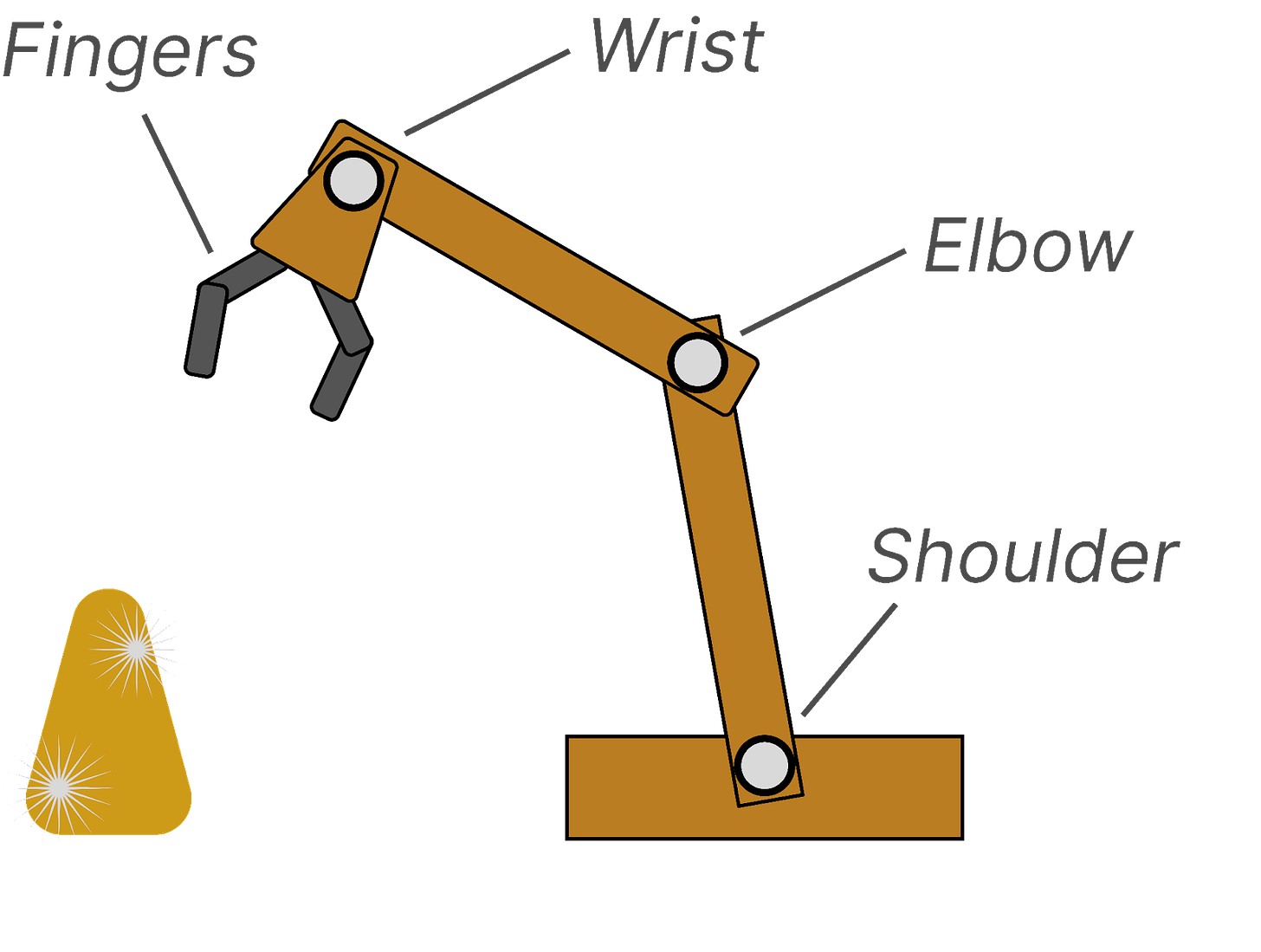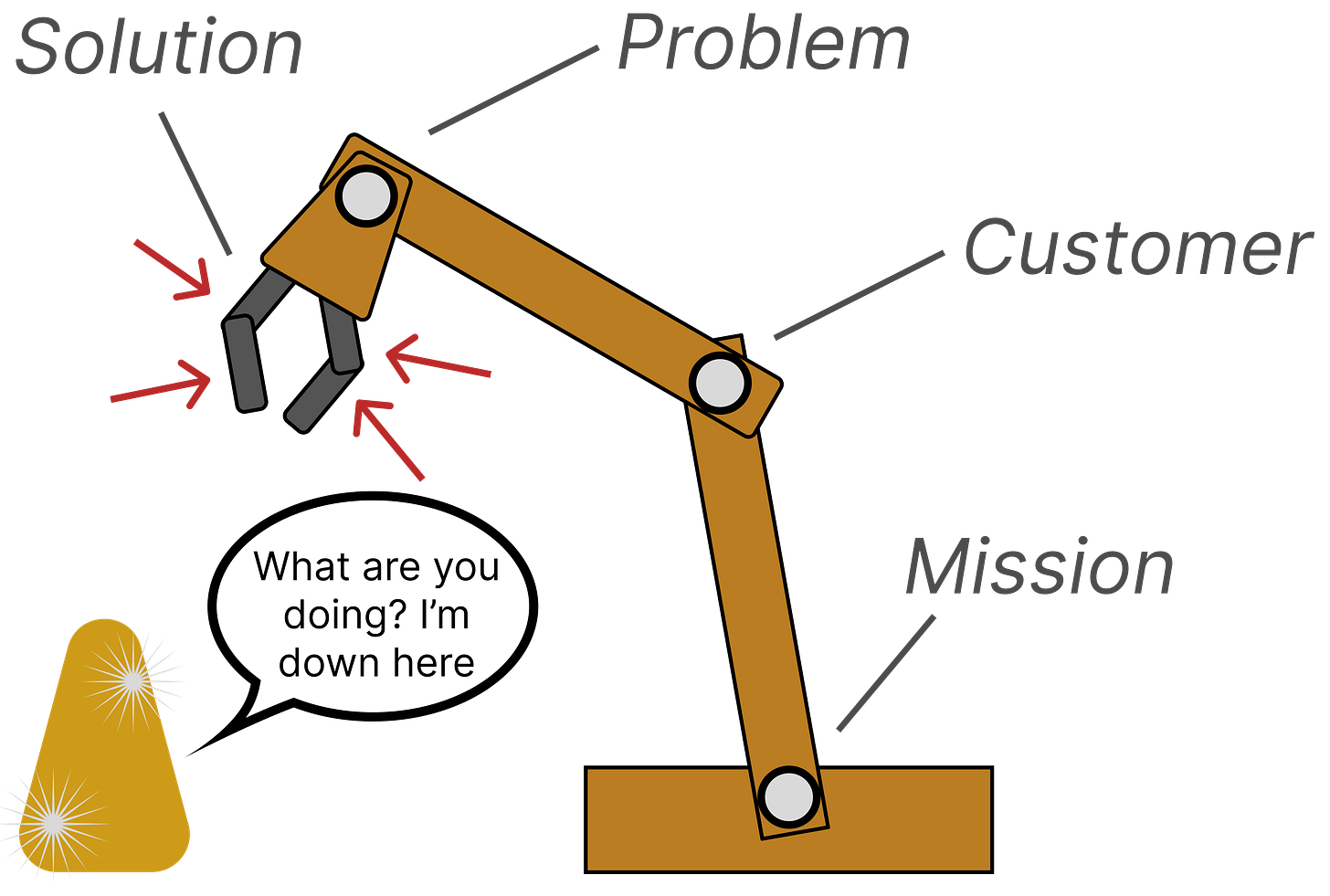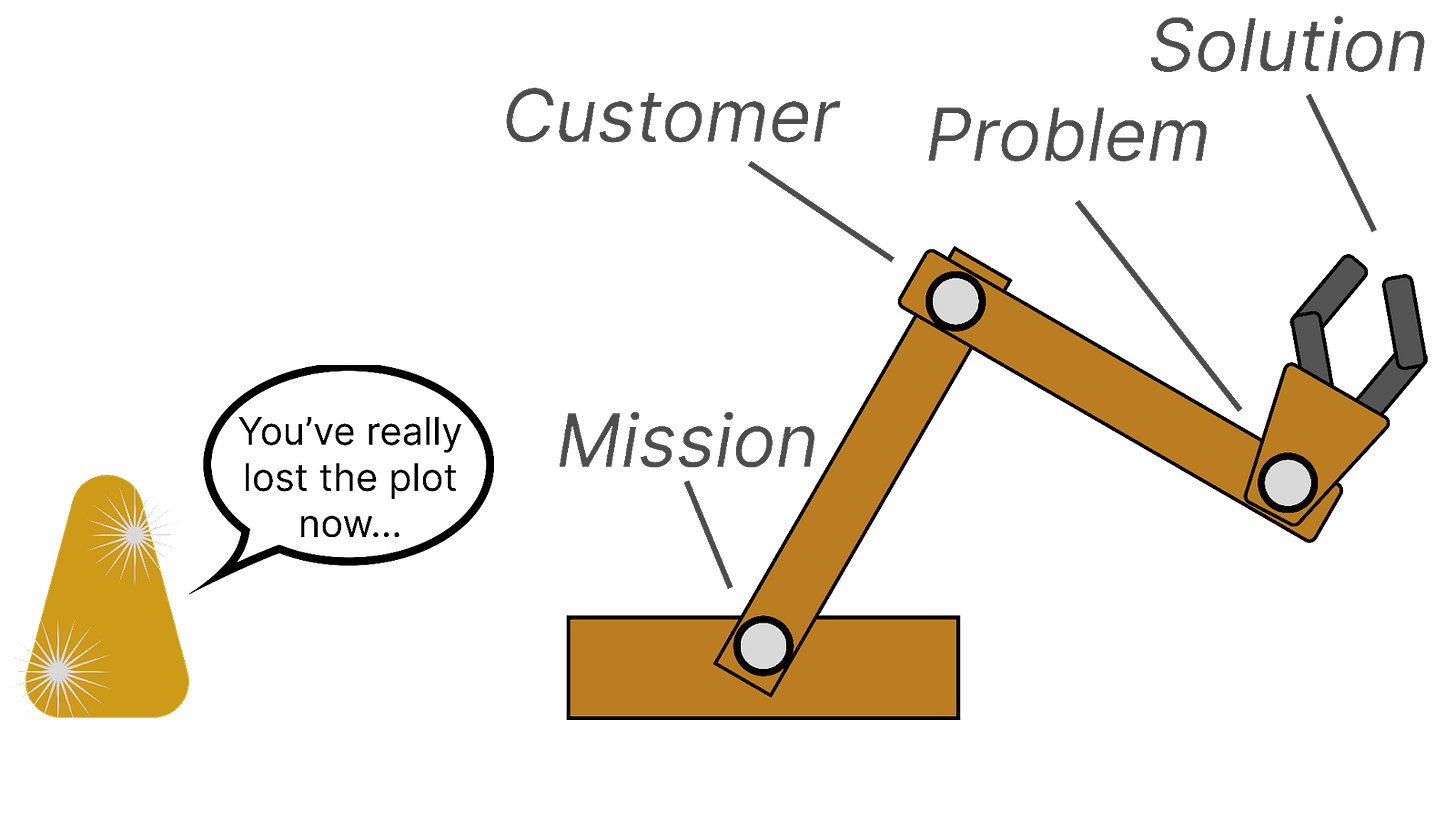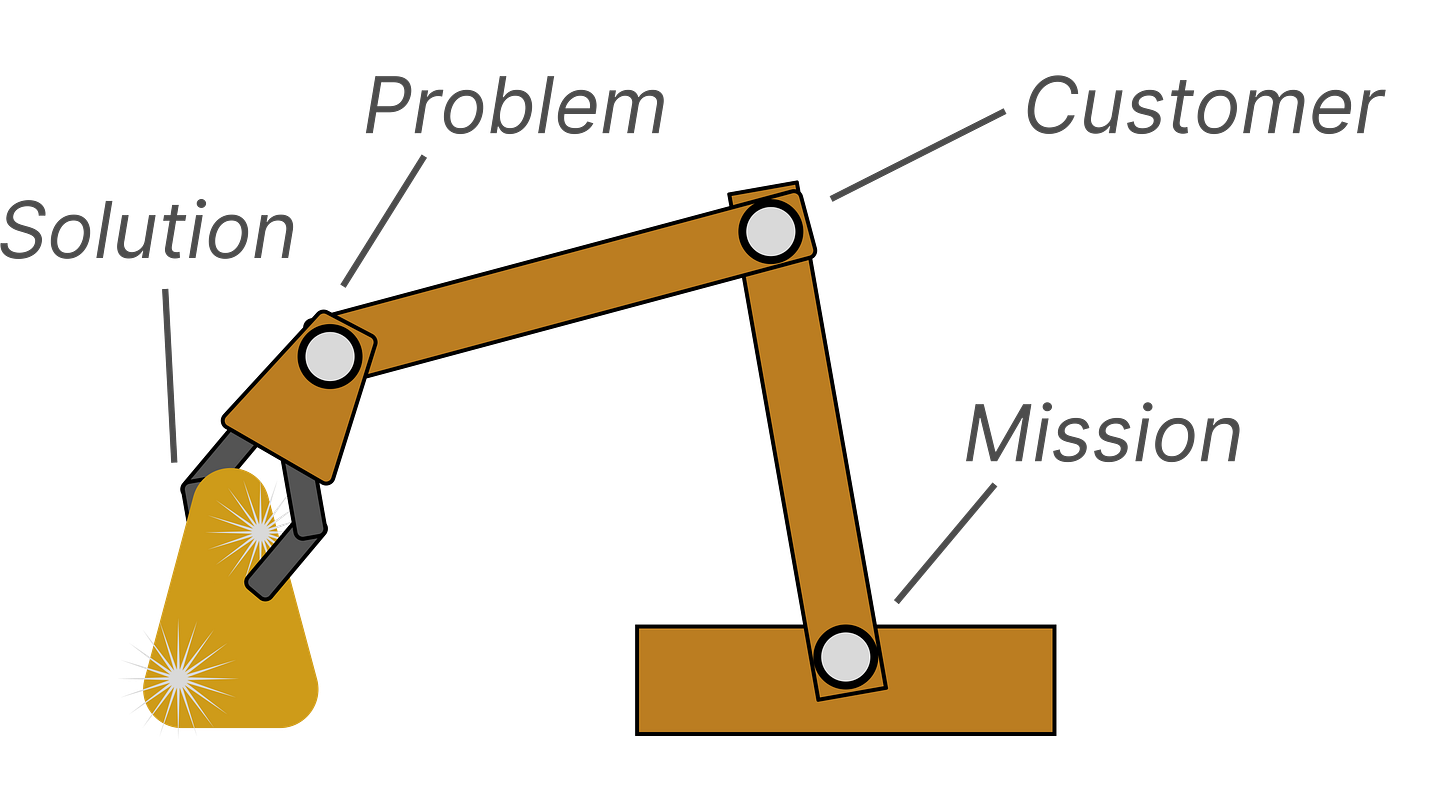The Four Dials Framework for Pivoting a startup
Why startups often think about pivots backwards
At some point in their life, most startups will pivot. A big mistake we made with our startup is an under-appreciation of how some pivots look small on the surface, but are in fact huge, and vice-versa. We used to think about pivot size completely backwards, which led us to sell to a customer we didn’t understand, fixing a problem that wasn’t worth solving, in service of a mission we didn’t believe in.
We’ve written about our own experience making this mistake in the story of our startup. In this post, we’re going to introduce The Four Dials framework for thinking about pivoting. This model is how we’d think about pivots in the future.
The Four Dials Framework
Imagine you are operating a robot arm with the control panel below. Each of the four dials controls the corresponding joint in the arm. Your goal is to grab the golden nugget with the arm.
How would you approach this? I expect you wouldn’t turn all the dials simultaneously - that’s a recipe for chaos. Similarly, I wouldn’t expect you to start by adjusting the fingers - what good will that do if the golden nugget is still far away? The strategy that makes sense is to first position the shoulder, then the elbow, then the wrist, and finally the fingers. There’s a natural hierarchy that exists between the four joints of the robot arm, corresponding to the four dials.
Much like robot arm operators, startup founders also have a control panel with four dials. They’re similar to the robot-arm dials but with different names:
Just like the robot arm, these dials are hierarchical. At any given point in time, founders should be able to answer the following four questions about your startup, corresponding to the four dials:
Mission → What change do we want to see in the world?
Customer → Who can our company help in service of the mission?
Problem → What problems can we help them with?
Solution → How can we help them solve these problems?
Over the course of a startup's life, the answers to these questions will change. This is a pivot. However, not all pivots are made equal. A common mistake is to start tuning your solution dial before giving proper thought to your mission and customer dials. Especially if you’re an engineer, this is tempting because tinkering with solutions is fun. However, it’s wasted effort if you’ve not yet decided on where to set your mission, customer and problem dials.
If you ever have thoughts like “I wonder if our product could instead be used by X to help them with Y'' then you’re considering a huge pivot. That’s okay, but don’t underestimate what you’re getting yourself into. Changing your mission or customer means making a significant change that may have unintended consequences. Are you sure that the new customer really cares about the problem you're trying to solve? It can be tempting to think of changing your customer as a small pivot and changing your solution as a big pivot. This is backwards.
For robot arm operators, no amount of adjusting the finger dial is going to help if the golden nugget is on the other side of the room. For founders, iterating on your solution before being clear on your mission, customer, and problem is a waste of time.
The Four Dials in a Real-World Example
You believe that people who want to build muscle should lift barbells with good form. You observe that people struggle with their form, which puts them off. To solve this problem, you make a phone app where users can video themselves lifting and get feedback on their form using AI-powered video analysis. You set your four dials as follows:
Mission: To help people reach their physique goals with a simple approach to strength training
Customer: Beginner gym-goers
Problem: It’s hard to learn how to lift barbells properly
Solution: App with video analysis of barbell lifting form
After launching, you learn that people are reluctant to video themselves in the gym. Beginners struggling with their form are already self-conscious, and they find setting up their phone to video themselves draws more attention. After this setback, you’ll need to pivot. Here are two possible ways you could approach it.
The big pivot that seems small
You ask yourself, who wouldn’t feel self-conscious about videoing themselves exercising? You conclude that people following workout videos at home won’t have this problem, seeing as they’re in a private environment. If they’re following a video playing on their phone then they’re already in front of a camera too, so no camera setup is needed. Although most people that work out at home don’t use barbells, we can still re-use our existing technology for analysing form for people lifting with dumbbells. Genius!
However, let’s look at this pivot through the lens of The Four Dials. We’ve made major changes to three of the dials, and only a minor change to the solution dial.
Mission: ???
Customer: People following home workout videos
Problem: It’s hard to learn how to workout at home properly
Solution: App with video analysis of dumbbell lifting form
You’re surprised that your new product isn’t popular, so you start talking to people that follow home workout videos. You learn that they do care about getting their form right, but they struggle much more with consistency. Form doesn’t matter to them if they’re not working out regularly in the first place. This pivot from gym-goers to home workouts was a huge pivot that went unnoticed. This is the big trap with moving the solution over to a new customer: they may have a whole new stack of problems you're not aware of, rendering your solution worthless to them. Most importantly, our strategy after the pivot no longer aligned with our founding mission: To help people that want to build muscle with a simple approach to strength training. To avoid this, founders should take great care when pivoting their mission or customer.
The small pivot that seems big
What might a smaller pivot look like? Given that beginners are reluctant to film themselves, how else could we fulfil our mission? You realise that the reluctance-to-film issue could be solved by instead selling a discrete camera that sticks to the squat rack in the gym, which connects to the user’s phone via bluetooth. This way, people wouldn’t need to draw attention to themselves but can still get video analysis on their form.
On the surface, this appears to be a huge pivot as we’ve now introduced a hardware component. However, let’s look again at this through the lens of The Four Dials:
Mission: To help people reach their physique goals with a simple approach to strength training
Customer: Beginner gym-goers
Problem: It’s hard to learn how to lift barbells properly
Solution: Discrete camera that connects to an app for video analysis of barbell lifting form
We've kept the same mission, customer, and problem from our original idea. While it might seem like a big deal to change your solution so drastically, the pivot is much less likely to lead to becoming the dreaded “solution-in-search-of-a-problem”.
Take away lessons
Not all pivots are created equal. Pivoting your mission, customer, or problem is a much larger pivot than pivoting your solution.
Founders should take great care when pivoting their mission or customer. How much do you really care about this new mission? How well do you understand this new customer’s problems?
Iterating on your solution before being clear on your mission, customer, and problem is a waste of time. Make sure to have these more important aspects in place first before tinkering with your solution.
Further reading
If you enjoyed this post, you may also like:
This post is heavily based on our personal experience running a fitness-tech startup. You can read our story here.
We plan to write more about the importance of having a company mission. Sign up to our email list below to be notified when the post goes live.








